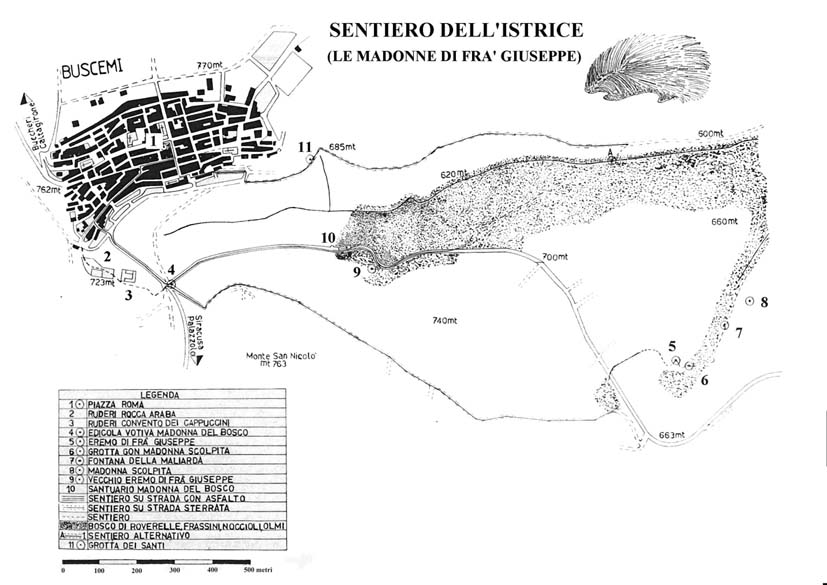BUSCEMI
![[Panorama di Buscemi]](pano.jpg)
Important Historical Notes
The inhabited citycenter of Buscemi is lying on a hill of the Iblei
ca. 700 m above sea-level. The place with its extraordinary placement reminds
of a big natural theatre which dominates the Anapo- valley and is seated
between the antique rests of Akrai, Casmene and Pantalica. Numerous testimonies
do date the origins of the first primitive agglomerates to the late bronce-times.
After this, there are no really sure notices until the V-VI century d.C.
In the Byzantine times, the formation of a more complex instalment was
retaken at the seat of the Buscemi of our days. First historical notices
are known from Arabic times like for example the name Qal'at Abi Samah,
which was developed in the following times over Buxema, Bussema and Buscema.
The cruel earthquake from 1693 destroyed the old city and gave place to
the Buscemi of today, which, mainly in the religious buildings, is showing
many elements of the baroque.
Important feastdays
Feast of the " Madonna del Bosco" (4. Sunday of august) .
Feast of the Crucifix (1 Sunday of mai ).
Celebration of the pizza and the " impanate" ( rural pizza) (3. Sunday of august).
Easter celebrations.
How to reach Buscemi
From Catania: S.S. 194 CT-RG Buccheri- Buscemi, Km 68
From Syracuse: S.S. 287 Palazzolo- Buscemi, Km 52
From Ragusa: RG- Giarratana, S.124 Buscemi, Km 36
Suggestions for itineraires in and outside the city
- Etnoantropologic and architectonic itinerary - inner-city
- track of l'Istrice" - itinerary naturalistic extra city
Etnoantropologic and
architectonic itinerary (inner-city)
The etnoantropologic way through Buscemi is considering all the city- centre
and leads through small lanes of the medieval quarter to living- and working
places of the population. This ambient is very original and testimony for
living and working situations in whin the different social realities took
place and so gives an extraordinary example of the "rural population"
of the IBLEI. The living and working structures, this way contains, are:
"putia ro firraru, casa ro massaru, parmientu, casa ro iurnataru,
putia ro falignami, trappitu, putia ro scarparu e r'appuntapiatti"
(see the following explanations). The itinerary begins with the visitation
of the blacksmith (firraru) that is placed in an artificial cave which
might have been a Christian meeting point in earlier times. The presence
of the old blacksmith (forger), who is still working there using the traditional
tools (anvil, forge etc.) makes this lets this place become an in this
mountain zone unique testimony. One continues with the visit of the millstone
(parmientu), the place in which they do the winepressing. This structure
of the beginnings of the XIX century is completed by a Greek wine-press,
which has its origins in the I century A.C. In the inner-part, a permanent
exhibition illustrates the story of the grape and the modes working and
transforming it, from Greek times till today. Going down a little bit,
one finds himself in front of the harmonic façade of the church
of S.Antonio di Padova (XVIII century). Its sinusoidal plant presents particular
rare architectonic structures of the baroque. Only some metres away, there
is the bailiffs house (casa ro massaru), the house that shows structurally
the living reality of the middle class of the peasant class. It shows four
different ambient: the kitchen whit the traditional tools, the entrance,
where the reed grating a collation of cow and sheep collars and various
working implements are conserved, the room in which the cycle of the folk
weaving is shown and then the bedroom with the cradle, the trunk with a
large dowry,and the typical clothes.
INFORMATIONS
Infoline about this etnoantropological toor:
Sig. Acquaviva -"Associazione per la conservazione della cultura contadina Iblea".
tel / fax +39-931878528.
Track of the "Istrice"and "Madonne di Fra' Giuseppe"
if you want zoom clic the pictures
useful Information
Duration: 3 hours Lenght:5Km Difficuty: easy Difference in level: da 750 meter (Piazza Roma) a 723m. (ruderi del castello Requesenz) a 763m. (Monte S. Nicolò) a 650 (eremo di Fra Giuseppe) a 550 (torrent "valle di Pietra") a 700m. (Santuario Madonna del Bosco) back to Piazza Roma.
Equipment: boots, cap, water bottle etc.
infoline: tourist department c/o municipio: 0931-878273 fax 0931-878476.
![[campagne di Buscemi]](campi.jpg)
campagne intorno a Buscemi
Historical notes about the paths
In the sanctuary of the "Madonna del bosco", there are a fresco
which depicts the virgin with the child Jesus and a wood statue of the
Patron Saint of the town. The Patron feast is done on the fourth Sunday
of August. The hermitage which is made of two small grottoes is the place
where the mystical Brother Joseph, an hermit born in Buscemi in 1891, stayed.
When he was young , he decided to engrave skulls and crosses on the rock
and he was told to be able to do miracles by witness. He died in Buscemi
on April 1975. Nowadays, his grave and the hermitage are still a place
of pilgrimage. The Castle Requesenz, an original Arabic architecture, was
used by different dynasties like Normandy one or Aragon one. After the
earthquake in 1963, it was rebuilt and used as a monastery for cappucian
monks. On the IX century, it was used as a cemetery and then was abandoned
by the monks.
